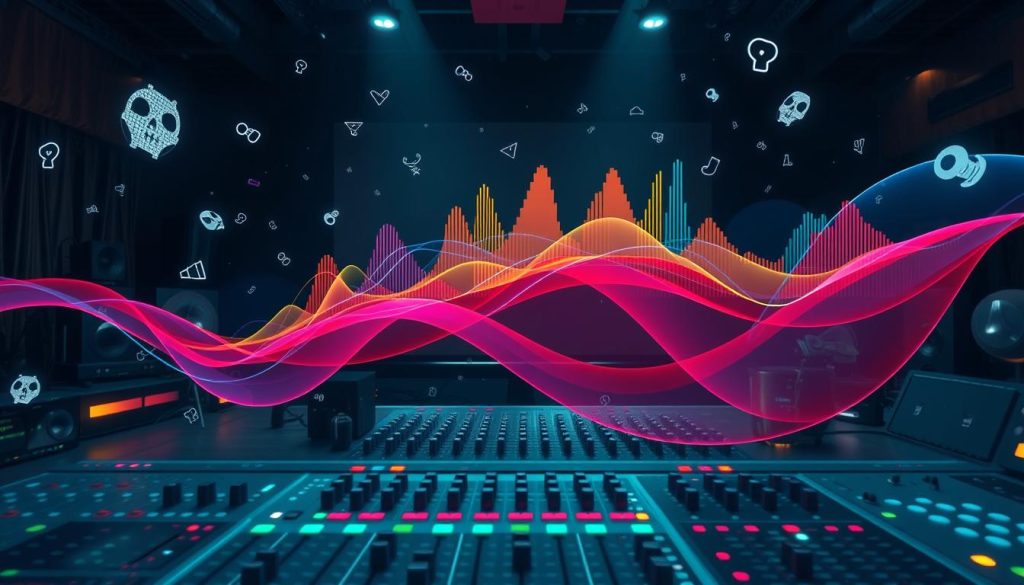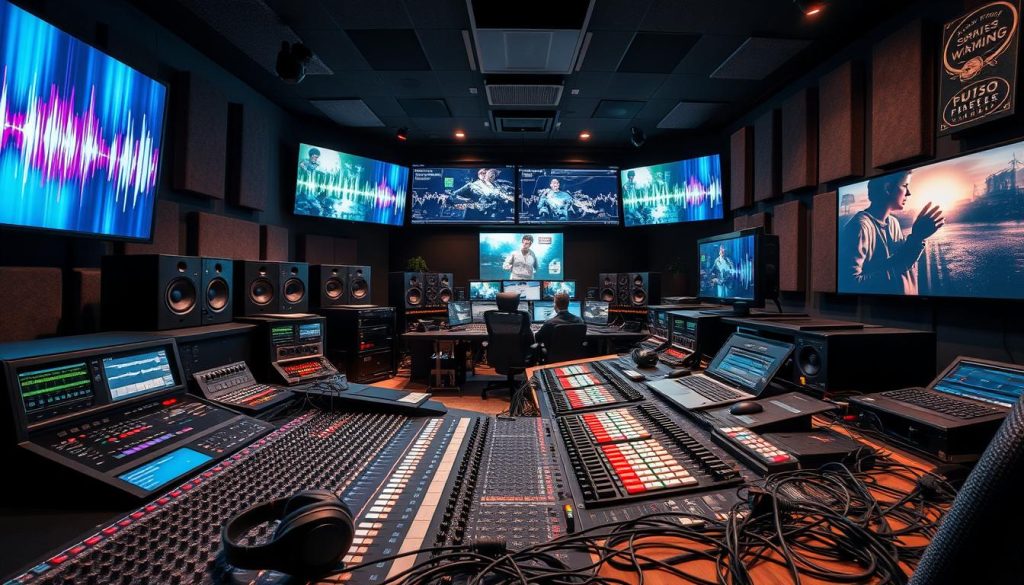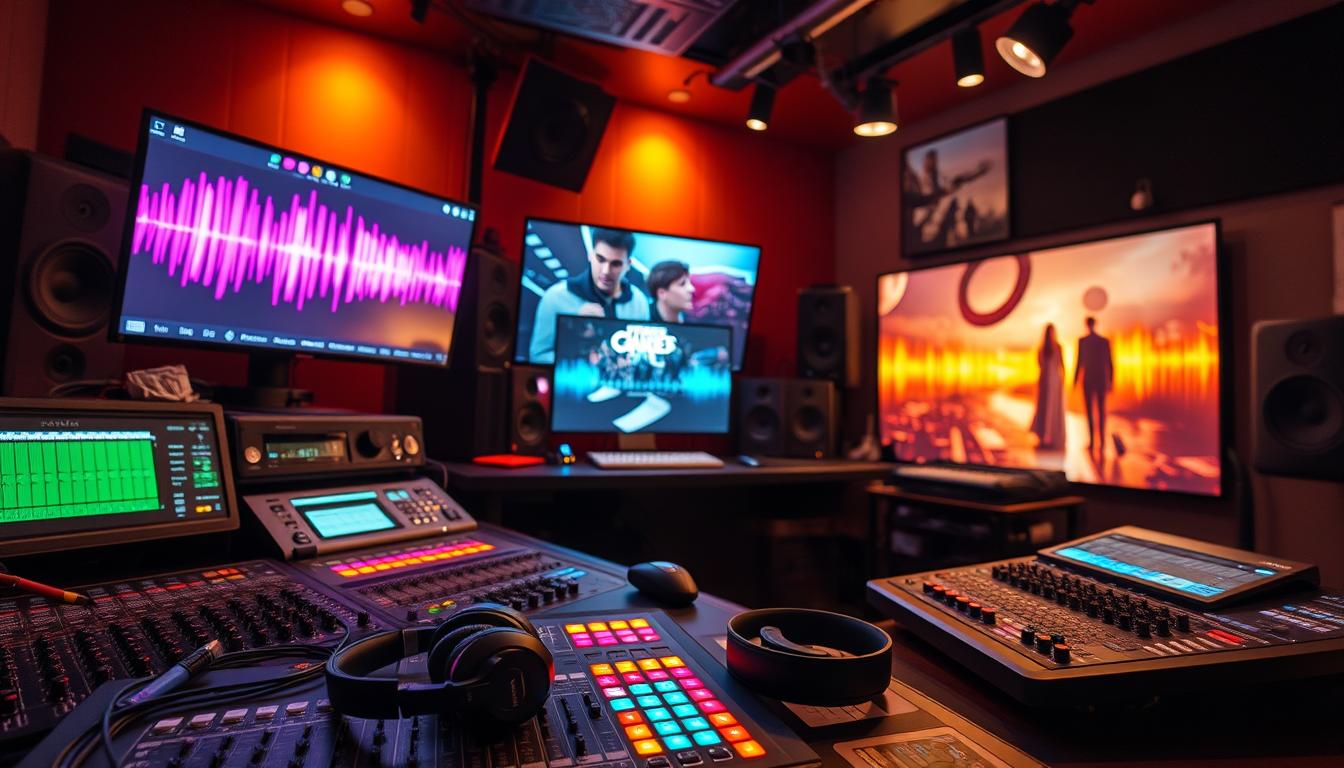I love movies and how sound design changes the experience. It takes us to new worlds with its sounds. The art of sound mixing is amazing.
In this article, we’ll look at how movies come alive with their sound. We’ll see the techniques and tech behind it.
Sound design makes movies feel real. It mixes sounds like effects, dialogue, and music. This creates powerful soundscapes that make us feel things.
Techniques like making unique soundscapes and using foley effects are key. Choosing the right music is also important. Over time, sound design has grown a lot. It started with silent films and now we have amazing tech to make sounds.
Understanding Sound Effects in Film
As a filmmaker, I’ve always been drawn to how sound effects make movies come alive. From the quiet background noise in films that set the mood to the detailed foley effects that make actions seem real, each sound is key to pulling us into the story.
Ambient Sounds
Ambient sounds are the quiet noises that make us feel like we’re really there. They can be the sound of leaves rustling, cars driving by, or thunder in the distance. Sound designers use special techniques to mix these environmental sound effects together. This makes the movie feel more real.
Foley Effects
Foley effects are all about making everyday sounds in a studio. Foley artists use props to record sounds like footsteps, opening doors, and touching objects. These synchronized sound design bits are then matched with what we see on screen. This makes the movie feel more real.
Special Effects Sound
Special sound effects add the big, magical, or otherworldly sounds we can’t hear in real life. This includes loud explosions, magic spells, futuristic sounds, or the voices of fantastical creatures. Sound designers use creative techniques to make these sound design for VFX sounds.
By mixing these sounds, filmmakers can take us to new places, make us feel more, and make movies more immersive.
Techniques for Mixing Sound Effects
As a sound mixing pro, I know making great movie audio is more than just adding sound effects. It’s key to balance sound levels so they don’t drown out the dialogue or music. I use equalization (EQ) to make sure each sound has its own space in the mix.
Balancing Levels
For film audio mixing, it’s all about getting the sound levels right. I adjust each sound’s volume carefully. This makes sure the dialogue is clear and the sound effects and music add to the movie.
Creating Spatial Depth
Adding depth to sound effects is vital. I use panning and reverb to place sounds in the right spots. This makes the sound feel like it’s coming from different places, pulling the audience into the movie.
Synchronizing Audio Cues
Getting the timing right with sound effects is crucial. I tweak the timing to match the visuals perfectly. This keeps the sound and picture working together seamlessly, making the movie more immersive.
| Technique | Description | Benefits |
|---|---|---|
| Balancing Levels | Carefully adjusting the volume of sound effects, dialogue, and music to create a harmonious blend. | Ensures that the audience can clearly hear the dialogue while still feeling the impact of the sound effects and music. |
| Creating Spatial Depth | Using panning, reverb, and other spatial processing techniques to place sound elements in specific locations within the audio field. | Helps to create an immersive, three-dimensional soundscape that seamlessly integrates with the visual environment. |
| Synchronizing Audio Cues | Adjusting the timing of individual sound effects to achieve perfect alignment with the corresponding visual elements on screen. | Maintains the illusion of realism and cohesion, enhancing the overall cinematic experience. |
Layering Sound Effects for Depth

Film sound design is amazing because of layering sound effects. This makes the sound deep, textured, and real. It’s hard to get this with just one sound.
First, a strong ambient soundscape is set. This is the base for adding more sounds. Each sound has its own spot in the mix, making the sound rich and full.
For a busy city scene, start with city sounds like traffic and people talking. Then add sounds like a bus rumbling by or a car honking. By mixing these sounds right, the scene feels real and pulls you in.
Sound effect layering is key for immersive soundscapes and adding depth in sound design. It makes movies more engaging, pulling you into the story.
sound mixing for movies

As a professional copywriting journalist, I’m excited to explore film sound mixing. This process is key to making movies feel real. It involves mixing sound effects, dialogue, and music to create depth and sync with the movie.
Sound mixing is all about blending sounds to make a movie feel complete. Engineers and mixers need to know a lot about sound and how people hear it. They use this knowledge to shape the movie’s sound world.
One big part of mixing sounds is balancing them. Mixers adjust levels so each sound fits well together. This makes sure the movie sounds good and doesn’t get too loud or too quiet.
Creating depth in sound is also important. Mixers use special techniques to make sounds seem like they come from different places. This makes the movie feel more real and pulls the audience in.
Matching sounds with what’s happening on screen is key. By doing this, mixers make the movie more emotional and easy to follow. They make sure the sounds and pictures work together perfectly.
Film sound mixing shows how important sound is in movies. Mixers and engineers work hard to make the sounds in movies great. Their skills and creativity make movies more engaging and memorable.
Tools and Software for Sound Effects
As a pro sound designer, I use many tools and software for making movie sounds. Programs like Pro Tools, Audacity, and Adobe Audition help me record, edit, and shape sounds. These tools are key for making sure each sound fits perfectly in the movie.
I also use digital signal processing (DSP) plugins for more advanced sound work. These plugins help me change the sound’s tone, texture, and where it seems to come from. This makes the sounds more real and deep.
For making specific sounds, I need special foley recording gear. This includes different props, surfaces, and mics. Using these, I can record the sounds of everyday things. Then, I use synthesizers, sampling tools, and sound design software to make new and creative sounds. These tools help tell the story in a unique way.

